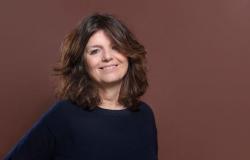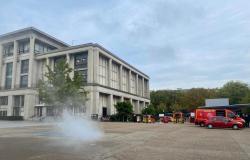
Q Maylis de Kerangal, this is the third book that you have published in Le Havre. How do you explain this need to anchor your stories there?
R I think it’s become a very matrix city for me. A city of fiction, the city of my novels.
How does a landscape, a city, a place, a place begin to resonate with a particular imagination? And even how can it infuse, or even rather diffuse, an imagination in my texts?
It’s true that it’s the town where I grew up. I spent my entire childhood and adolescence there. It’s the place where I trained in a certain way, where I read my first books, experienced my first love. It is the city of first times, of first experiences.
It is also a very particular city even in terms of its appearance because it was completely destroyed by the bombings of the Second World War. Another city has come to stand in place of the one that disappeared. And so, if you like, this configuration raises the question of the presence of a spectral, absent city, on which or in which today’s Le Havre has come to nestle, to take up residence. […]
It is also today one of the largest container ports on the western coast of Europe, with a huge crisis linked to drug trafficking.
In ports, there is really this whole question of the exchange of goods which are beings, feelings, stories, stories.
Le Havre is a city with a very particular dynamic. And there you have it, I refer to him in almost all my books. I wanted to do a book that was really more for her, perhaps, this time.
Q It’s a city that is both historic and very current, so basically very rich for a writer?
R Oui. […] The destruction of Le Havre is an enormous trauma and, at the same time, it is a city which has always retained a form of dynamism linked to its enormous port. I find that ports can be seen as great sensors of the contemporary world.
Le Havre has been emptied of its past and, however, it is a city which is completely confronted with contemporary stories such as migration and drug trafficking. She makes it all resonate for me.
Q The writing of Surf day has a rhythm that is both fast and very precise, but it also stretches out over long sentences. Would you say that this is a style specific to this novel?
R It’s true that I like that the writing of a book, the very material of the writing – its rhythm, its sound, its cadence – can restore the internal movement of the book and what it talks about.
There, it is a question of the undertow of memories, the undertow of memory. The language is quite choppy. There is this kind of feedback effect, therefore sentences which wind up, which envelop themselves and which can also give rise to digressions. Like when you dream, one thing makes you think of something else and then of something else again.
I find it interesting when, in the writing, there can be a trace of the very motif that we are trying to catch. When I wrote Repair the living (2014), a book about a heart transplant, I told myself that the writing had to recreate the cardiac impulse, whether it was a kind of cardiography.
In Birth of a bridge (2010), I wanted it to be a more “construction site” style of writing, very dense, very sonorous.
And there, Surf dayfor me, it is a writing that is more digressive, with these returning movements, both enveloping and escaping. Because it’s also a woman trying to recognize someone. So she makes assumptions; she dreams.
Le Havre is a city that is extremely conducive to daydreaming. It’s a city with very big skies, a very changeable climate. I wanted all this climatology to be able to be found in the writing.
Q According to you, is it this writing, this approach that most characterizes your works?
R I try to capture things, make them feel, vibrate and hear. […] I try to work more in sensitivity and also in knowledge. In this book, it is perhaps a little less central, but for a long time I had work that was very linked to more documentary forms.
This is the city I am exploring. For me there is always in this approach, in this wandering, a connection to sensitivity. She is a lonely woman. She returns to a town where she lived. She reconnects with her childhood, with her adolescence. Obviously, the history of the city comes back and it is a bit of a metaphor for this body found dead on the beach. […]
There is something in this book which is perhaps more digressive, more dreamy, more free and, I imagine, with the game, perhaps more personal, too, in a certain way.
Q Surf day is still part of the second selection for the 2024 Goncourt Prize. How do you receive this nomination?
R I receive it with great pleasure!
Right now it’s just about being on a list. But already, this presence sheds some light on your work. It’s also important for a new literary season to have this type of selection. I welcomed her with great pleasure. We’ll see what happens, but it’s true that I find that it’s already something that seals the course of the text. […]
When the book is present on a selection, it is true that it is immediately illuminated. And there you have it, it carries you, it gives you energy!
Surf day
Maylis of Kerangal
248 pages
In bookstore.





